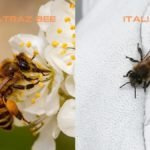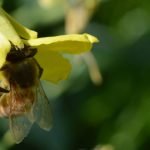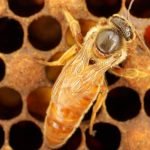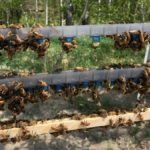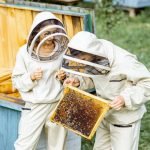What are Saskatraz bees? Saskatraz bees are a product of an initiative to breed a stable, disease-resistant highly productive bee derived from lines of bees in Saskatchewan. The bees are evaluated and then sent to Orland, California. Here the bees are bred and used for queen rearing to increase the available quantities of this breed of bees. In this article, we take a look at why this is an important initiative.
There are a few important issues in the concept of breeding that we need to evaluate. After this, we can delve into what the Sakatraz bee is. Let us run through this logically.
There are two very basic breeding concepts that we can use to create a type of animal.
Outbreeding of Honey Bees
In outbreeding, we try to incorporate maximum genetic diversity into a breed. Animals mix with the greatest range of genetic diversity they have. This is can be natural outbreeding. When the progression goes on for long enough a species with relatively uniform traits can evolve.
In nature, we have bee races that are relatively stable in appearance and characteristics in a region. These bees have been selected for by local conditions and are adapted to that area. An example is Apis mellifera sahariensis. Particularly this bee is uniquely adapted to be able to survive on date palm and desert flowers.
This bee was bred by nature and is uniquely adapted to its environment. If we bring human “wisdom” in trying to tinker with a landrace we normally experience unexpected results. We often find that in the short term there is a gain and in the long term a loss. This is because we tend to take outbred animals and select desirable traits by inbreeding. Let us explore the next strategy.
Inbreeding of Honey Bees
Unlike outbreeding, with inbreeding, we take closely related individuals with traits we deem beneficial. We combine these and keep selecting for the traits we want. Consequently, this allows us to rapidly select for a trait such as “honey production”. Let us demonstrate how this can be a problem by using humans as an example.
Crossing Successful Broodstock in Bees
Let us imagine we have two athletes who are male and female. Both are Olympic gold medal winners for running. They fall in love and have children. The chances that those children have good genes for Olympic athletics are high. The couple has a son and a daughter. These children both go on to become Olympic athletes and win gold medals.
Inbred Problems for Beekeepers
If the son and daughter were to have kids it would be a major controversy. Secondly, the kids would probably have some sort of problem. Because they are inbred. Consequently, you may find these offspring may still be able to wind gold medals in the Olympics. Their ability to understand calculus may however be compromised. Inbreeding invites problems.
What Are Saskatraz Bees and How Do They Avoid Inbreeding?
It is abundantly clear that the majority of bee stocks in North America are demonstrating symptoms of being inbred. Increased disease, reduced vibrancy, and loss of genetic diversity are evident.
The clever breeding team behind the Saskatraz bee has chosen a brilliant strategy to try and breed disease resistance, diversity, and honey productivity back into bees. This sort of thing really needs to be encouraged as it will actually save the honeybee.
Source Of The Bees
The majority of the queens chosen for the breeding program are sourced from the numerous hives operated by Meadow Ridge Apiary in Saskatchewan. They also source queen cells from other apiaries in the region where bees demonstrate beneficial traits. There is consequently a constant stream of genetic diversity which is flowing into the breeding program.
This is a crucial strategy for us to employ in most breeding programs in the future, as genetic diversity is a strength. I salute the Saskatraz team for being an example of thought leaders and activists in this regard.
Learn more about: Buckfast Bees
A Beekeepers Breeding Strategy
The first step is to concentrate the diverse queens from various apiaries into open mated natural selection apiaries. Here mite and disease resistance is evaluated. Other selection apiaries are established and also stocked with diverse queens and allowed to open mate. These are selected for economic honey production traits. Over a period of a few years, this resulted in enrichment for beneficial genetic traits. These queens were then bred into a combined hybrid strain resulting in bees with disease resistance and honey production traits.
The important factor here however is that the breeding strategy is really to produce a genetically diverse bee with beneficial characteristics. Guided natural selection enriched with human observation helps a lot. Screening for hygienic traits, varroa resistance, disease resistance, and honey production is routine. This is a broad category of traits based on the constant enrichment of this gene pool.
The California Bee Connection
Saskatchewan is a great place to produce honey. The area has cold winters and a short growing season. It is not an ideal queen-rearing region. To multiply and expand the queen line, it is necessary to do so in a warmer climate. This is crafty because it allows queen production to start earlier. Consequently, queens can be ready for the Saskatchewan spring.
Queen bees from Saskatchewan are sent to breeding sites in places such as Orland, California. Here expert breeders evaluate breeder queens. They further select for disease resistance and honey production traits through a very extensive evaluation process. The result is a well-bred, genetically diverse bee. It produces good honey crops and requires less chemical intervention for disease control.
What To Expect Of Your Saskatraz Bees
This is a hybrid bee that is outbred. It has been selected for gentleness, honey production, disease resistance, and overall health. Consequently, this is not an inexpensive bee. When you purchase Saskatras bees you are actually investing in a very sensible breeding program. In my area sadly I cannot experiment with this bee. If I had to choose a list of commercial queens that I wanted to try, this would be at the top of my list.

This is an excellent started genetic source for developing your own locally adapted strains. To allow your own outbreeding you could allow these to cross with local swarms that you catch from bee removals you will develop a local bee. Often bees that survive on their own without help are disease resistant and locally adapted.
What are Saskatraz bees? Little miracles of clever selection! I hope you enjoyed this article and are rushing to book your Saskatraz bees. Share if you enjoyed it.
Read more about: Carniolan Honey Bees vs Italian Honey Bees
Saskatraz Bees FAQs
What are Saskatraz bees known for?
Saskatraz bees are known for their disease resistance, high honey production, and overall health. They were bred through a program in Saskatchewan to enhance genetic diversity and bee survival.
Why were Saskatraz bees developed?
They were developed to address growing concerns of bee inbreeding, disease, and lower honey production by breeding bees that are both resilient and productive.
Where do Saskatraz bees originate?
Saskatraz bees originated in Saskatchewan, Canada. They are bred using diverse genetic lines and are later sent to California for further queen rearing and selection.
How do Saskatraz bees differ from other bee breeds?
Saskatraz bees are outbred, meaning they are genetically diverse. This makes them more resistant to diseases and pests compared to many inbred bee strains.
What traits are Saskatraz bees selected for?
These bees are selected for disease resistance, honey production, gentleness, and overall hardiness, making them an ideal choice for beekeepers seeking strong, low-maintenance colonies.
How are Saskatraz bees bred?
They are bred using a combination of outbreeding and natural selection. Queen bees from diverse sources are open-mated, and the offspring are selected for desirable traits such as mite resistance and high honey yield.
Can Saskatraz bees survive harsh climates?
Yes, these bees are bred to survive in the harsh winters of Saskatchewan. However, their queens are reared in warmer climates like California, ensuring earlier production for beekeepers in colder regions.
Are Saskatraz bees suitable for commercial beekeeping?
Yes, Saskatraz bees are ideal for commercial beekeeping. Their high honey production and low need for chemical treatments make them cost-effective for large-scale operations.
How do Saskatraz bees avoid inbreeding problems?
The breeding program continuously introduces new genetic material from diverse queen lines, preventing inbreeding and maintaining healthy, vibrant bee populations.
What should I expect when purchasing Saskatraz bees?
When you purchase Saskatraz bees, you are investing in a carefully bred, disease-resistant, and high-yield colony. They are known for their gentleness and productivity, making them a valuable addition to any apiary.

Dr. Garth A. Cambray is a Canadian/South African entrepreneur and beekeeper with 28 years of experience in apiculture and specializes in adding value to honey. His Ph.D. research developed a new advanced continuous fermentation method for making mead that has resulted in a number of companies globally being able to access markets for mead. His company, Makana Meadery, exports honey mead to the USA where it is available to discerning connoisseurs. He has also developed technologies to commercially manufacture organic honey vinegar in Zambia for export globally. He holds a few patents globally in the ethanol industry and believes in technology and knowledge transfer for human development and environmental sustainability. One of his proudest achievements is the fact that the wind farm he started at one of his old apiary sites has essentially made his hometown carbon neutral.

